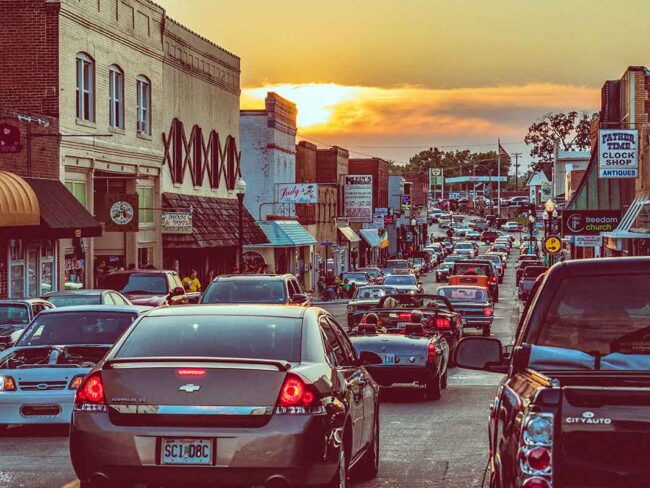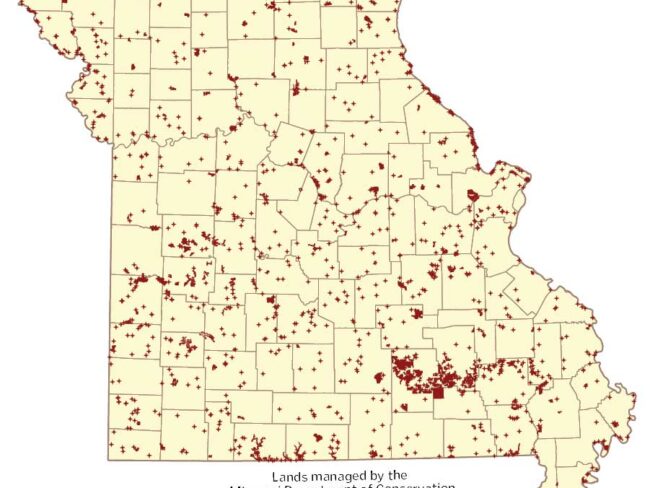We envision Missouri’s landscapes on its four hundredth birthday
This article originally appeared in our January/February 2022 edition.
Why try to imagine what’s going to happen two hundred years from now? That question haunted me as I talked to people for this essay. The idea came out of brainstorming how to close Missouri Life’s nearly two years of articles focused on our state’s recently concluded bicentennial. After so much time looking backward, I thought it would be a good idea to look forward for a change. I interviewed and read as many futurists as I could, so perhaps one possible answer is to give these experts a chance for their ideas about the future to be heard. But this answer doesn’t quite satisfy me.
After all, history is littered with examples of predictions made by experts being proven wrong—one immediately conjures an image of Harry S. Truman in St. Louis triumphantly wielding a copy of the Chicago Tribune with the headline “Dewey Defeats Truman” after Truman had been re-elected president.
Maybe that’s why most experts, including the ones I spoke to for this piece, bristle at the idea of having to make predictions about a distant future. The first person I spoke to holds a master’s degree in foresight. Madebo Fatunde, who is based in Cleveland, works as a member of the Guild of Future Architects, where part of his job involves imagining and anticipating the future.

“Two hundred years is a long time,” he says. Demographic projections don’t go too far past 2100, Madebo says, and my research never yielded any projections as far in the future as 2221. He suggested I start with what’s certain or near-certain to happen in the years to come and try to anticipate how those events could shape the world.
So I returned to the basic question: why bother with imagining the future at all? The future is a place to project our hopes, along with our doubts and uncertainties.
We may dream of traveling to a faraway place or worry about tomorrow’s weather. If the weather calls for snow, we’ll choose our footwear accordingly, and if we dream of traveling in the future, we know we need to make certain preparations today. Our expectations effect how we conduct ourselves in the present.
I wonder if imagining Missouri two hundred years from now can have a similar impact. If by exploring what could transpire throughout the next two centuries—the things that seem certain, the things no one could know, and everything in between—we might be able to imagine a future that will make an impact on the way we’re living today.
I reckon that for each of Missouri’s six million plus residents, our visions of the future of the state are as individual as snowflakes. So I’ve tried to distill what is known and unknown about Missouri’s future into a kind of scaffolding, which you can use to build your own vision of the Show-Me State in two hundred years. I’ve selected three basic lenses with which to examine the future: the natural environment, the built environment, and the virtual environment. Alongside this scaffolding you’ll see the artwork of Merit Myers, an artist who grew up in St. Louis and whose work illustrates one vision of the future. We invite you to imagine the future as you’d most like to see it, and to think about what Missourians living in the present day can do to reach that imaginary destiny.
The Built Environment
It is sunset in St. Louis on a September day in 2221. The city skyline viewed from the riverfront looks much the same as it ever has, with a few newer buildings with tall, curved construction that features multiple open-air levels replete with lush greenery. The Gateway Arch, gleaming silver, will celebrate its three-hundredth birthday thanks to careful preservation efforts. The retractable dome roof of Busch Stadium, made of a high-tech synthetic material capable of generating solar energy for the facility, is open to let in the temperate late summer air, and the roar of the crowd can be heard.
From the station not far away a maglev (magnet-powered, levitating) train departs for Kansas City with a stop in Columbia. A few minutes later another one, bound for Oklahoma City, will leave and chart a course through the state that roughly follows the trajectory Route 66 once did. On the interstates, driverless cars quietly speed toward their destinations, and the air is buzzing with autonomous drones—some deliver packages, while others carry passengers or collect data.
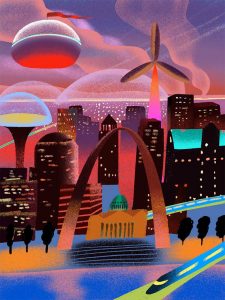 By 2100, Earth’s population is expected to grow from just under 7.7 billion today to as many as 12 billion, according to a report from the United Nations. Meanwhile, the percentage of people living in urban areas is also on the rise, projected to reach 70 percent worldwide by 2050. If those changes occur, we can safely expect Missouri’s cities to grow, and Missouri’s built environment will change in the process.
By 2100, Earth’s population is expected to grow from just under 7.7 billion today to as many as 12 billion, according to a report from the United Nations. Meanwhile, the percentage of people living in urban areas is also on the rise, projected to reach 70 percent worldwide by 2050. If those changes occur, we can safely expect Missouri’s cities to grow, and Missouri’s built environment will change in the process.
“In the year 2021, we are doing our part to lay the groundwork and provide the tools and resources necessary to overcome the next drought, flood global pandemic, or whatever may come next.”
—Governor Mike Parson
Some of the technologies that will shape these changes are already coming to fruition. Driverless cars and delivery drones seem like an inevitable part of the human landscape, and these technologies will shape the way development takes place, especially in urban areas.
Imagine an apartment building with a convenient drop-off location on the first floor. After you exit your autonomous car, it drives itself to the underground garage and parks itself. When you come in the door, you notice a package arrived by drone in your outdoor drop zone, and with the push of a button, it’s gently deposited inside.
In a statement to Missouri Life when we queried him about what he saw or hoped for the future, Governor Mike Parson touted a renewed commitment to the state road fund, with the hope that “you in the future have quality roads and bridges that are safe, efficient, support tourism, and increase business investment and relocation in Missouri.” Although infrastructure upgrades may lack the aesthetic appeal of the Jetsons-inspired future cities, infrastructure changes will be integral for the future of Missouri’s built environment. Some of these changes, like road improvements, are already in the works. Kansas City’s streetcar was just awarded $50 million in funding from the US Department of Transportation to expand its track by three miles, and in St. Louis, expanded pedestrian and bicycle networks are in the development and planning phases.
A National Geographic article on future cities mentions just a few of the principles of a city’s architecture, including water, waste, food, and mobility. The infrastructure for all of these systems will need to be carefully planned to accommodate a growing population and a warmer climate, and our ability or failure to engage in this kind of thinking will be reflected in the built environment.
Part of the ability to make these plans is knowing where to build and where to leave nature to its course.
One of the most dramatic shifts in the built environment around us could come in the form of a reduction in rural development. For example, the Big Muddy National Fish and Wildlife Refuge comprises sixteen thousand plus acres of land willingly sold by owners. Instead of developing this land for use, it’s been ceded to nature. Aside from providing wildlife habitat, this land also gives water from major floods somewhere to go, and scientists predict flooding will grow increasingly more common in the coming years.
This refuge was mostly farmland before being sold, but flood prone population centers like Rhineland, which moved up a nearby hill, and Devil’s Elbow, which many landowners have moved away from, could also go in a similar direction. It’s worth noting that Missouri history is full of instances of strategic retreat from natural threats. Look no farther than the original sites of Ste. Genevieve and Franklin for examples. This kind of managed dismantling of the built environment could serve as a model for future planning of areas both urban and rural.
We humans—Missourians, in particular—are a crafty, adaptive species.
Perhaps the futuristic cities and reclaimed wild natural areas we imagine now will read to citizens of Missouri in 2221 the way ambitious predictions of flying cars and personal domestic androids from the mid-twentieth century strike us today. Although we don’t know how Missouri’s built environment will develop, we have an idea of the forces that will shape it. We hope that Missourians in 2221 have architecture that adequately meets their needs, a tribute to the ambition and the wisdom of generations who came before them.
The Natural Environment
Knowing what Missouri’s natural landscape will look and feel like in 2221 is a question of knowing what our climate will be like. The concept of climate change is probably the one thing that everyone I spoke to mentioned or alluded to. Although Governor Parson didn’t reference climate change directly, he mentioned challenges often connected to it.
“When my administration began in 2018, we faced a historic drought. The next year, we were challenged by historic flooding.” Later in the statement, he goes on to say: “In the year 2021, we are doing our part to lay the groundwork and provide the tools and resources necessary to overcome the next drought, flood, global pandemic, or whatever may come next.”
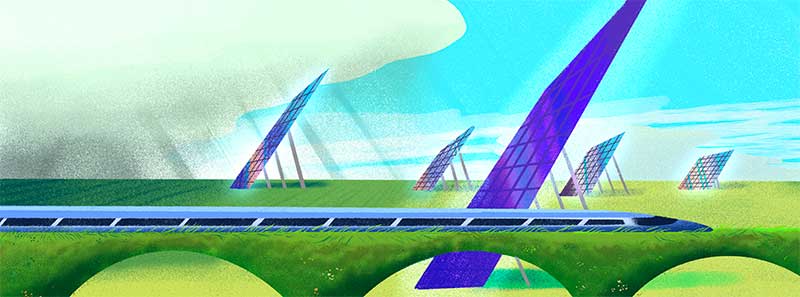
Floods, fires, droughts—they all figure heavily into visions of our future. Missouri’s climate has changed. According to a report by Patrick Guinan, state climatologist for Missouri and Director of the Missouri Climate Center, “for twenty out of the past twenty-three years (1998-2020), the annual minimum temperature has been above average.” That average stretches back to 1895.
In the report, entitled Missouri’s Changing Climate, Patrick outlines a few possibilities for the region based on current projections. These include the addition of twenty days to “frost-free season” between 2035 and 2065. In general, the rise in drought events is likely to increase our natural environment’s susceptibility to invasive species. Those droughts will also disproportionately affect young trees, which could have a profound impact on the composition of Missouri’s forests by raising the mortality rate of young trees. The report also posits that increased humidity, rainfall, and intense rain events are projected to increase, and the warm season temperatures are expected to rise “more in the Midwest than any other region in the US.”
By midcentury, heat and humidity in Missouri will feel like Louisiana does today.
Another report by ProPublica and The New York Times Magazine analyzed climate research and projections from scientists to make some predictions about wildfires, farm crop yields, and wet bulb temperatures, which are conditions where a combination of heat and humidity prevent the body from being able to cool itself by sweating. Among other findings, the report projects that “by midcentury, heat and humidity in Missouri will feel like Louisiana does today.”
The report also found that wildfires were likely to increase moderately throughout the state, and that farm crop yields would fall in some places while increasing in others, mostly in the state’s northern counties. All of the available modeling suggests milder winters, more rainfall in cooler seasons, and more drought in the warm seasons. Although these changes will have a dramatic effect on Missouri, our state compares favorably in terms of habitable conditions when compared with the arid southwest and low-lying coastal areas in decades to come.
While the Upper Midwest is projected to be among the most climate-stable regions in the country over the long term, the ProPublica report still places most of Missouri inside “the human climate niche,” (that is, the kind of environment humans are most adapted to live within) as far in the future as 2070. In the meantime, other regions of the country, the continent, and the world will be falling outside that niche, which makes mass migration more likely.
Will Missouri be home to those seeking a more hospitable climate in the future? It is entirely possible.
What happens beyond 2100 is much more difficult to parse. Missouri has made efforts to reduce its carbon emissions, but as a 2011 United Nations report explained, warming trends may continue for decades or centuries because of the carbon dioxide already in the atmosphere. But we humans, Missourians in particular, are a crafty, adaptive species. Finding ways to engineer increased stability on a global scale may be possible, and the minds that contribute to such a project may already be living here.
The Virtual Environment
We’ve only just begun to witness the machinations of this epoch of technology. It seems likely that Missouri’s virtual environment could be the most radically different in two hundred years’ time of any frontier we’ve explored thus far.
It will begin with changes to the built environment, namely, the spread of broadband like the railroad and electricity before it, to the more rural nooks and crannies of our state. Once again, Governor Parson makes reference to this in his statement:
Expanded broadband will create a more level playing field for rural areas.
“We are also making major investments to expand broadband all across our state, and we hope that by the time this letter is read every home, business, school, and farm has access to high quality broadband connectivity and greater opportunity.”
Madebo Fatunde of the Guild of Future Architects encourages exploring the possibilities that the expansion of virtual networks could entail. “It’s possible for the whole world to just be covered by networks,” he says. “But what are the social effects of that? And then, how does rural life change?”
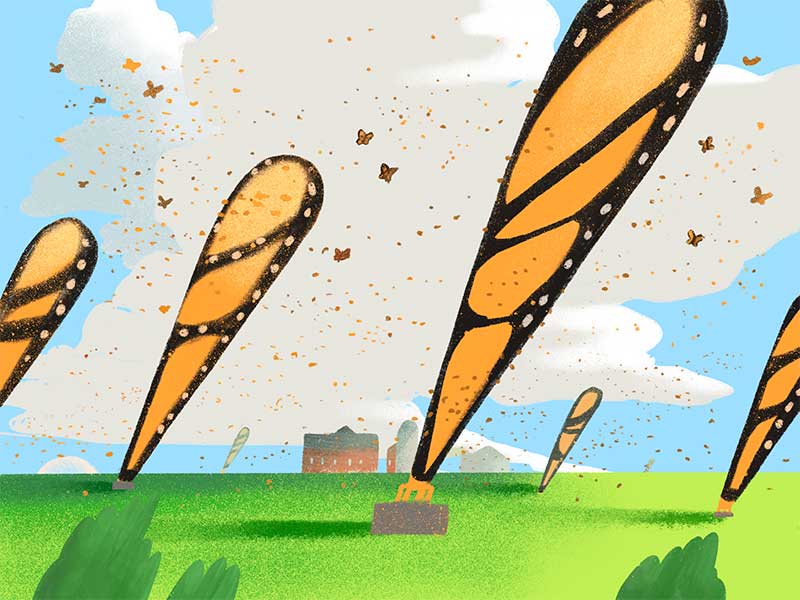
This could lead to some interesting outcomes for people attracted to the lower cost of living or proximity to family in rural areas.
Not long from now, developments in artificial intelligence, virtual reality, and other emergent technologies could alter the world in ways so drastic I can scarcely bring myself to imagine them. These are just the changes that are likely to take place in my lifetime. And yet, the impact of these changes is more likely to be global than local.
The virtual landscapes accessible to people in Missouri will probably be the same as those accessible in Illinois or Kansas. While Missouri’s virtual landscape may be the same as everywhere else, future technologies could also be employed to bring more people to Missouri than ever before and help us bring a new dimension to the way we interact with our history.
For example, visitors at Kansas City’s Union Station can already today use their smartphones to explore an interactive interpretive program that brings the building’s history to life. Someday we could perhaps use similar technology to see the Missouri River as it was when Lewis and Clark explored it, or to see the mounds built by Mississippian culture that once dotted the landscape where St. Louis is today. Perhaps we could use technology to simulate an immersive experience in Missouri’s natural environments from the comfort of our homes—and better still if these kinds of interpretive exhibits were available to anyone with an internet connection anywhere across the world.
Whatever our technological future holds, I don’t doubt that Missouri minds, perhaps molded at some of the Show-Me State institutions on the cutting edge of the tech world, will play a role in shaping it.
A Word to Future Missourians
And now, a note to the real people living in Missouri in 2221, should they stumble across this issue of Missouri Life. Maybe you’ll call Missouri something else by then, or at least have finally settled as a populace whether we pronounce it Missour-uh or Missour-ee. I’m sure the speculative future I’ve conjured in the paragraphs above missed the mark on several accounts. By now there’ll have been leaps forward in technology and world events I could never have anticipated, and I hope you’ve indulged yourself with a laugh at my naivete.
I also hope that you find Missouri a pleasant place to be. I can assure you that in spite of the pandemic and other challenges life offered in the year of Missouri’s two-hundredth birthday, it could still be charming, friendly, mystifying, and in certain moments downright breathtaking. The world will have changed in so many ways by now, but I hope that you find these qualities are as indelible as I imagine them to be.
I want you to know that, for my part, I’m rooting for you, and so are most of the people I know, being as you are descendants of those of us who were living here when this was written and are long gone now. We hope you’ll remember us as wise and prudent caretakers of our state who did our best, despite our flaws, and we hope you will be too.
Share your own ideas for Missouri’s future by emailing us at [email protected]. Please place “future” in the subject line.
Related Posts
Revitalizing Missouri Downtowns
Here’s how Missourians are working together to revitalize downtowns across the state.
STATE-TISTICS: Conservation Areas in Missouri
Conservation areas by the numbers

